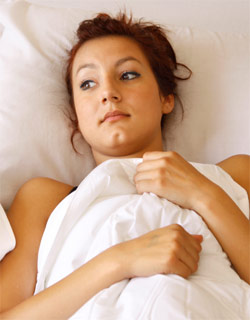|
|
|
 , ,
Font size |
Anorgasmia or Coughlan's syndrome: A Complete Insight

An estimated 10 to 15 percent of women have anorgasmia, or the inability
to reach orgasm after “adequate” sexual stimulation.
Anorgasmia, or Coughlan's syndrome is a type of sexual dysfunction in which a
person cannot achieve orgasm, even with adequate stimulation. In males, it is
most closely associated with delayed ejaculation. Anorgasmia can often cause
sexual frustration. Anorgasmia is far more common in females (4.7 percent) than
in males and is especially rare in younger men. The problem is greater in women
who are post-menopause.
Causes of Anorgasmia
The condition is sometimes classified as a psychiatric disorder. However,
it can also be caused by medical problems such as diabetic neuropathy, multiple
sclerosis, genital mutilation, complications from genital surgery, pelvic trauma
(such as from a straddle injury caused by falling on the bars of a climbing
frame, bicycle or gymnastics beam), hormonal imbalances, total hysterectomy,
spinal cord injury, cauda equina syndrome, uterine embolisation, childbirth
trauma (vaginal tearing through the use of forceps or suction or a large or
unclosed episiotomy), vulvodynia and cardiovascular disease.
A common cause of situational anorgasmia, in both men and women, is the use of
anti-depressants, particularly selective serotonin reuptake inhibitors (SSRIs).
Post-SSRI sexual dysfunction (PSSD) is a name given to a reported iatrogenic
sexual dysfunction caused by the previous use of SSRI antidepressants. Though
reporting of anorgasmia as a side effect of SSRIs is not precise, studies have
found that 17–41% of users of such medications are affected by some form of
sexual dysfunction.
Another cause of anorgasmia is opiate addiction, particularly to heroin.[6] Beat
icon William S. Burroughs chronicled this problem (amongst many others) in his
novel Naked Lunch. About 15% of women report difficulties with orgasm, and as
many as 10% of women in the United States have never climaxed. Only 29% of women
always have orgasms with their partner.
Primary Anorgasmia
Primary anorgasmia is a condition where one has never experienced an orgasm.
This is significantly more common in women, although it can occur in men who
lack the gladipudendal (bulbocavernosus) reflex. Women with this condition can
sometimes achieve a relatively low level of sexual excitement. Frustration,
restlessness, and pelvic pain or a heavy pelvic sensation may occur because of
vascular engorgement. On occasion, there may be no obvious reason why orgasm is
unobtainable. In such cases, women report that they are unable to orgasm even if
they have a caring, skilled partner, adequate time and privacy, and an absence
of medical issues which would affect sexual satisfaction. The attention and
skill of one's partner are not inextricably linked to woman's internal, implicit
comfort level.[citation needed] Thus, anorgasmia in a woman whose partner is
adequately attentive and skilled should not be regarded as a clinical mystery.
 Some social theorists believe that inability to orgasm may be related to
residual psychosocial perceptions that female sexual desire is somehow 'wrong,'
and that this stems from the age of Victorian repression. It is thought that
this view may impede some women – perhaps those raised in a more repressed
environment – from being able to experience natural and healthy sexual feeling. Some social theorists believe that inability to orgasm may be related to
residual psychosocial perceptions that female sexual desire is somehow 'wrong,'
and that this stems from the age of Victorian repression. It is thought that
this view may impede some women – perhaps those raised in a more repressed
environment – from being able to experience natural and healthy sexual feeling.
Secondary Anorgasmia
Secondary anorgasmia is the loss of the ability to have orgasms (as opposed to
primary anorgasmia which indicates a person who has never had an orgasm). The
cause may be alcoholism, depression, grief, pelvic surgery (such as total
hysterectomy) or injuries, certain medications, illness, estrogen deprivation
associated with menopause, or rape.
Prostatectomy
Secondary anorgasmia is close to 50% among males undergoing prostatectomy; 80%
among radical prostatectomies. This is a serious adverse result because radical
prostatectomies are usually given to younger males who are expected to live more
than 10 years. At more advanced ages, the prostate is less likely to grow during
that person's remaining lifetime. This is generally caused by damage to the
primary nerves serving the penile area, which pass near the prostate gland.
Removal of the prostate frequently damages or even completely removes these
nerves, making sexual response unreasonably difficult.
Situational Anorgasmia
People who are orgasmic in some situations may not be in others. A person
may have an orgasm from one type of stimulation but not from another, achieve
orgasm with one partner but not another, or have an orgasm only under certain
conditions or only with a certain type or amount of foreplay. These common
variations are within the range of normal sexual expression and should not be
considered problematic.
A person who is troubled by experiencing situational anorgasmia should be
encouraged to explore alone and with his or her partner those factors that may
affect whether or not he or she is orgasmic, such as fatigue, emotional
concerns, feeling pressured to have sex when he or she is not interested, or a
partner's sexual dysfunction. In the relatively common case of female
situational anorgasmia during penile-vaginal intercourse, some sex therapists
recommend that couples incorporate manual or vibrator stimulation during
intercourse, or using the female-above position as it may allow for greater
stimulation of the clitoris by the penis or pubic symphysis or both, and it
allows the woman better control of movement.
Random Anorgasmia
Some people are orgasmic but not in enough instances to satisfy their sense of
what is appropriate or desirable. Therapy can help such people examine and
realign their expectations of orgasm and of sexual activity. For some people,
therapy can help people become more comfortable with momentarily giving up
control to bodily responses.
Diagnosis of Anorgasmia
Effective treatment for anorgasmia depends on the cause. In the case of
women suffering from psychological sexual trauma or inhibition, psychosexual
counselling might be advisable and could be obtained through general
practitioner (GP) referral.
 Women suffering from anorgasmia with no obvious psychological cause would need
to be examined by their GP to check for absence of disease. Blood tests would
also need to be done (full blood count, liver function, oestradiol/estradiol,
total testosterone, SHBG, FSH/LH, prolactin, thyroid function, lipids and
fasting blood sugar) to check for other conditions such as diabetes, lack of
ovulation, low thyroid function or hormone imbalances. The normal thresholds for
these tests and timing in a woman's menstrual cycle is detailed in Berman et
al., 2005. Women suffering from anorgasmia with no obvious psychological cause would need
to be examined by their GP to check for absence of disease. Blood tests would
also need to be done (full blood count, liver function, oestradiol/estradiol,
total testosterone, SHBG, FSH/LH, prolactin, thyroid function, lipids and
fasting blood sugar) to check for other conditions such as diabetes, lack of
ovulation, low thyroid function or hormone imbalances. The normal thresholds for
these tests and timing in a woman's menstrual cycle is detailed in Berman et
al., 2005.
They would then need to be referred to a specialist in sexual medicine. The
specialist would check the patient's blood results for hormonal levels, thyroid
function and diabetes, evaluate genital blood flow and genital sensation, as
well as giving a neurological work-up to determine the degree (if any) of nerve
damage.
Recently, it has been proposed to add a subtype of FOD, called reduced orgasmic
intensity, and field trials are underway to assess the suitability of this
proposal.
Treatment of Anorgasmia
Just as with erectile dysfunction in men, lack of sexual function in women
may be treated with hormonal patches or tablets to correct hormonal imbalances,
clitoral vacuum pump devices and medication to improve blood flow, sexual
sensation and arousal.
Over the years the Hitachi Magic Wand, a large, powerful vibrator, has become a
fixture in courses that teach women how to reach orgasm. In 2008 Danish research
showed that more than 93% of a group of 465 chronic anorgasmic women could reach
orgasm using Hitachi Magic Wand and the Betty Dodson Method. Dodson's books
include Liberating Masturbation, a self-published book that became a feminist
classic. In the case of nerve damage, research is currently being undertaken at
Johns Hopkins University to make damaged nerves in the human body regrow using
the enzyme sialidase. It is possible that in the future pelvic nerve damage
could be repaired in this way.
Many practitioners today treat both men and women who have SSRI-induced
developed anorgasmia with Sildenafil, more commonly known as Viagra. While this
approach is known to work well in men with sexual dysfunction, it is only
recently that the effectiveness of sildenafil in women with sexual dysfunction
is coming to light. A recent study by H. G. Nurnberg et al. showed a complete or
very significant reversal of their sexual dysfunction upon taking sildenafil one
hour prior to sexual activity. In this study, eight out of the nine women
required 50 mg of sildenafil while the 9th woman required 100 mg of sildenafil.
Another option for women who have SSRI-induce anorgasmia is the use of
vardenafil. Vardenafil is a type 5 phosphodiesterase (PDE5) inhibitor that
facilitates muscle relaxation and improves penile erection in men. However,
there is much controversy about the efficiency of the drug used in the reversal
of female sexual dysfunction. Vardenafil is similar to sildenafil, but
vardenafil is less expensive and may be covered under some insurance plans. A
study by A.K. Ashton M.D. has shown that in the case of one particular woman,
the effects of vardenafil as opposed to sildenafil have not only been comparable
in the effectiveness, but that vardenafil is cheaper and reversal of sexual
dysfunction requires a smaller dose. So far, Vardenafil has been approved by the
Food and Drug administration only for use in men.
The NIH states that yohimbine hydrochloride has been shown in human studies to
be possibly effective in the treatment of male impotence resulting from erectile
dysfunction or SSRI usage (i.e. Anorgasmia). Published reports have shown it to
be effective in the treatment of orgasmic dysfunction in men.
 The chemical cabergoline, which is an agonist of D2 receptors, which in turn
decreases prolactin, has fully restored orgasm in 1/3rd of anorgasmic subjects,
and partially restored orgasm in another 1/3rd of subjects. Limited data has
shown that the drug amantadine may help to relieve SSRI-induced sexual
dysfunction. Cyproheptadine, Buspirone, stimulants such as amphetamines
(including the antidepressant bupropion), Nefazodone and Yohimbine have been
used to treat SSRI-induced anorgasmia. Reducing the SSRI dosage may also resolve
anorgasmia problems. The chemical cabergoline, which is an agonist of D2 receptors, which in turn
decreases prolactin, has fully restored orgasm in 1/3rd of anorgasmic subjects,
and partially restored orgasm in another 1/3rd of subjects. Limited data has
shown that the drug amantadine may help to relieve SSRI-induced sexual
dysfunction. Cyproheptadine, Buspirone, stimulants such as amphetamines
(including the antidepressant bupropion), Nefazodone and Yohimbine have been
used to treat SSRI-induced anorgasmia. Reducing the SSRI dosage may also resolve
anorgasmia problems.
To define a lack, you have to start by identifying what should fill it; to talk
about female anorgasmia, first you have to talk about orgasm. We tend to talk
around it, giving it cute nicknames: “the Big O,” “the grand finale.” Perhaps
unsurprisingly, it has no single, universally accepted definition. It’s usually
the result of sexual stimulation, but not always. Medical practitioners focus on
physiological bodily reactions—blood flow to the genitals, muscle tensing and
contraction—as the basis for orgasm, while psychologists look to the emotional
and cognitive changes that accompany it, such as the rush of the reward
chemical, dopamine, to the brain. When it comes down to it, though, the only way
to tell for sure that a woman has had an orgasm is if she tells you herself.
“You'll know it when it happens,” women who have experienced orgasm knowingly
advise those who have not, the way we were advised to wait for our first
periods—as if our first orgasms were events that would happen to us, experiences
we would receive, like some divinely imparted gift. But, what if orgasm doesn’t
come when we want it to—or at all?
Kayla, 25, is in a long-term, committed sexual relationship she calls
“considerate and supportive.” She has never climaxed—either alone or with a
partner. “Mentally, I have always been very open-minded about sex,” she tells
us. “I've always been curious about it and eager to try it, and I masturbated
from an early age, so no repression there…I refuse to believe there is anything
wrong with me solely mentally or physically—I prefer to believe it's a winning
combination of both.”
Kayla’s one of the estimated 10 to 15 percent of women with anorgasmia, or the
inability to reach orgasm after “adequate” sexual stimulation—not that we have
one definition of “adequate,” either, or even a clear understanding of what
causes anorgasmia. (We're not even sure of the degree of accuracy of that
much-cited 10 to 15 percent figure.) “We really don’t know if there are medical
causes for anorgasmia,” San-Francisco-based sex therapist Vanessa Marin
explains. “I would say probably for 90 to 95 percent of women who are
experiencing it, it’s because they have misinformation or a lack of information,
sexual shame, they haven’t really tried that much, or there’s anxiety—that’s a
huge one.”
Hope this insight about anorgasmia shall help our viewers in finding a solution
to this problem.
Dated 27 December 2014
|
|
|
|
|









